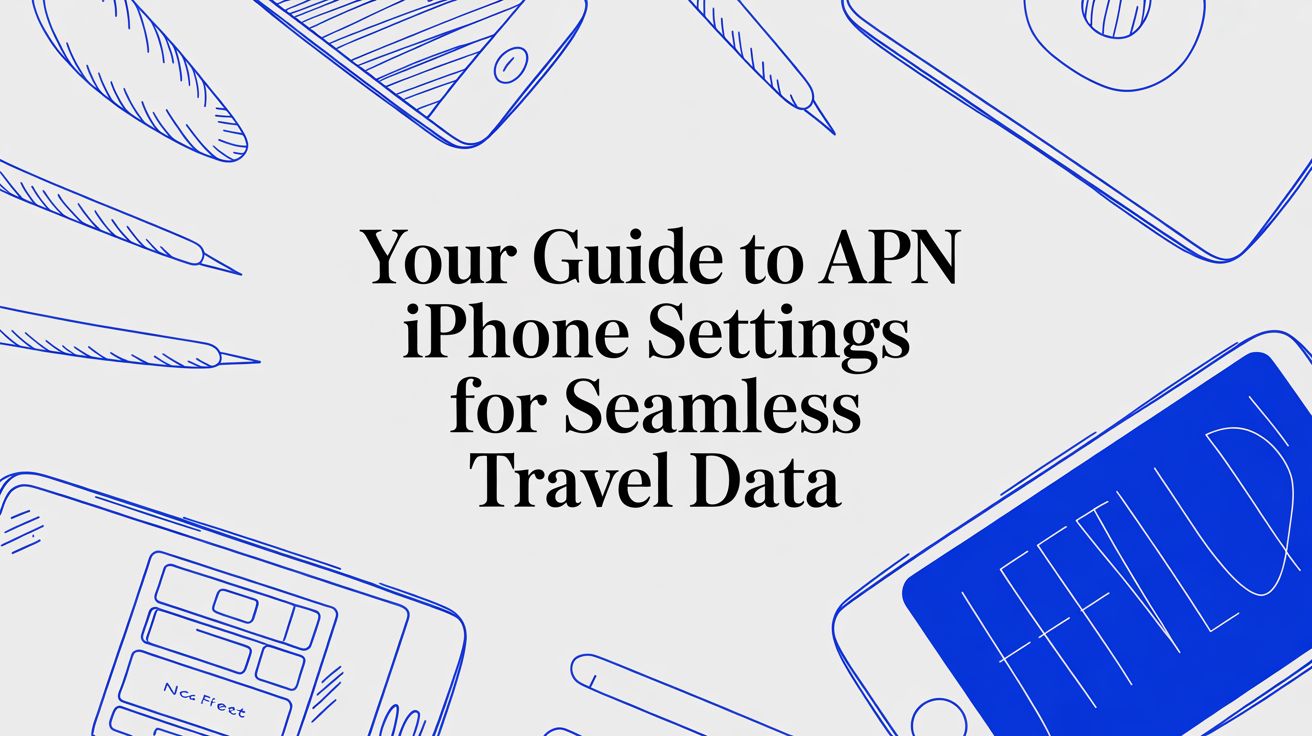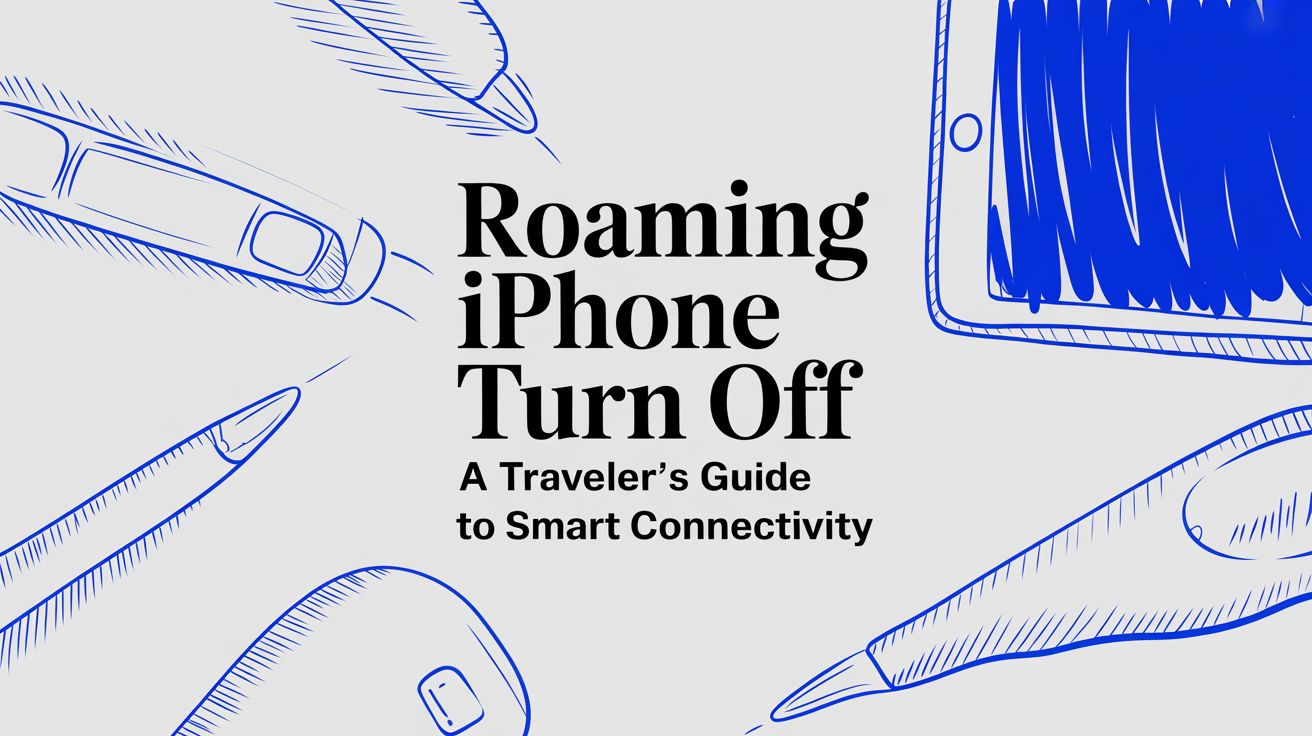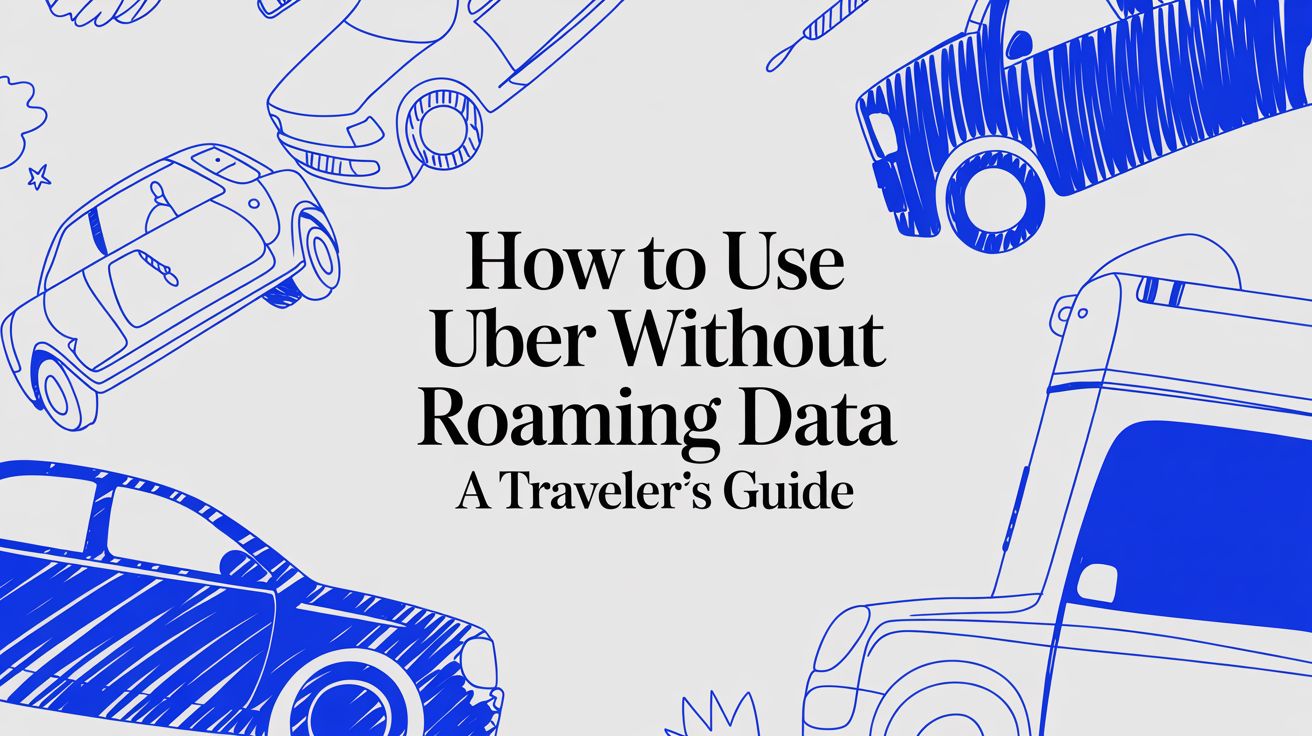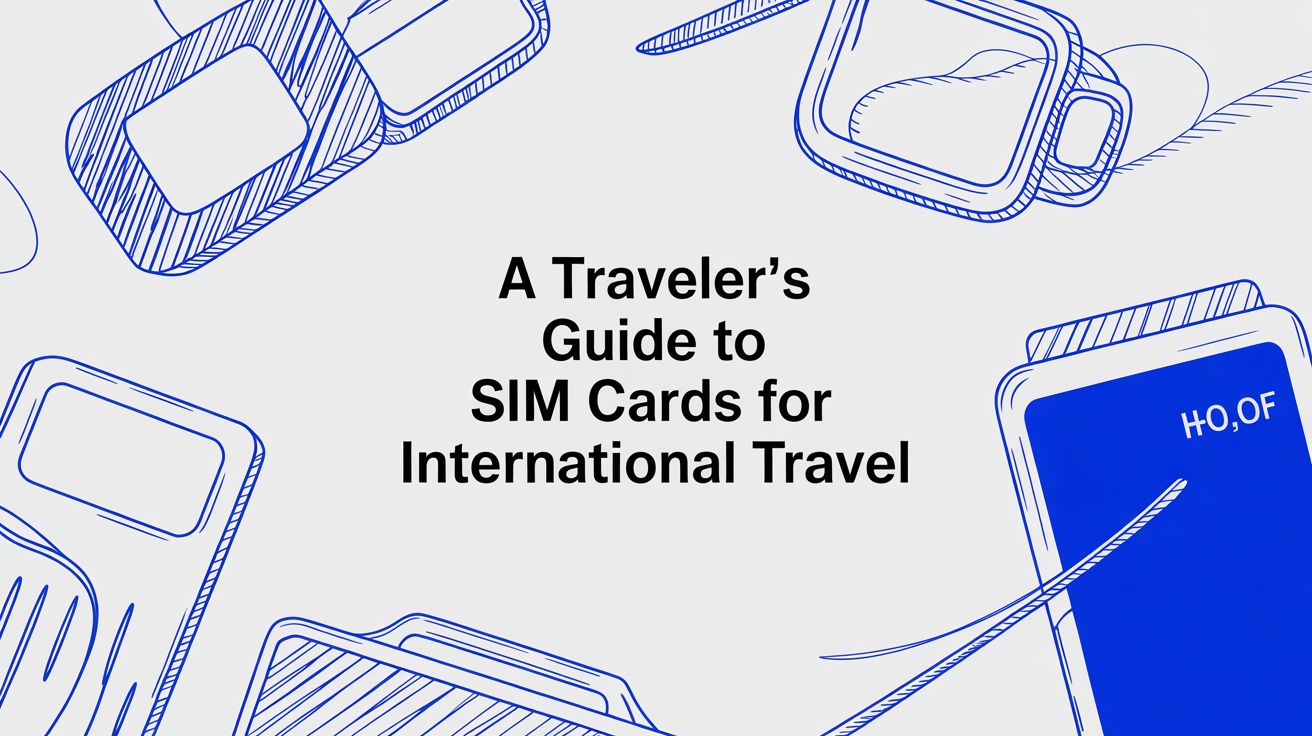

If you’re looking for the best travel eSIM, the honest answer is: it depends. The right choice hinges entirely on where you’re going and how much data you’ll need.
A short city break in Europe, for instance, a small eSIM might serve you well. But if you’re a digital nomad settling into Southeast Asia for a few months, the value of a bigger data package from a provider like TapSim is hard to beat. The trick is to match what the provider does best with the reality of your trip.
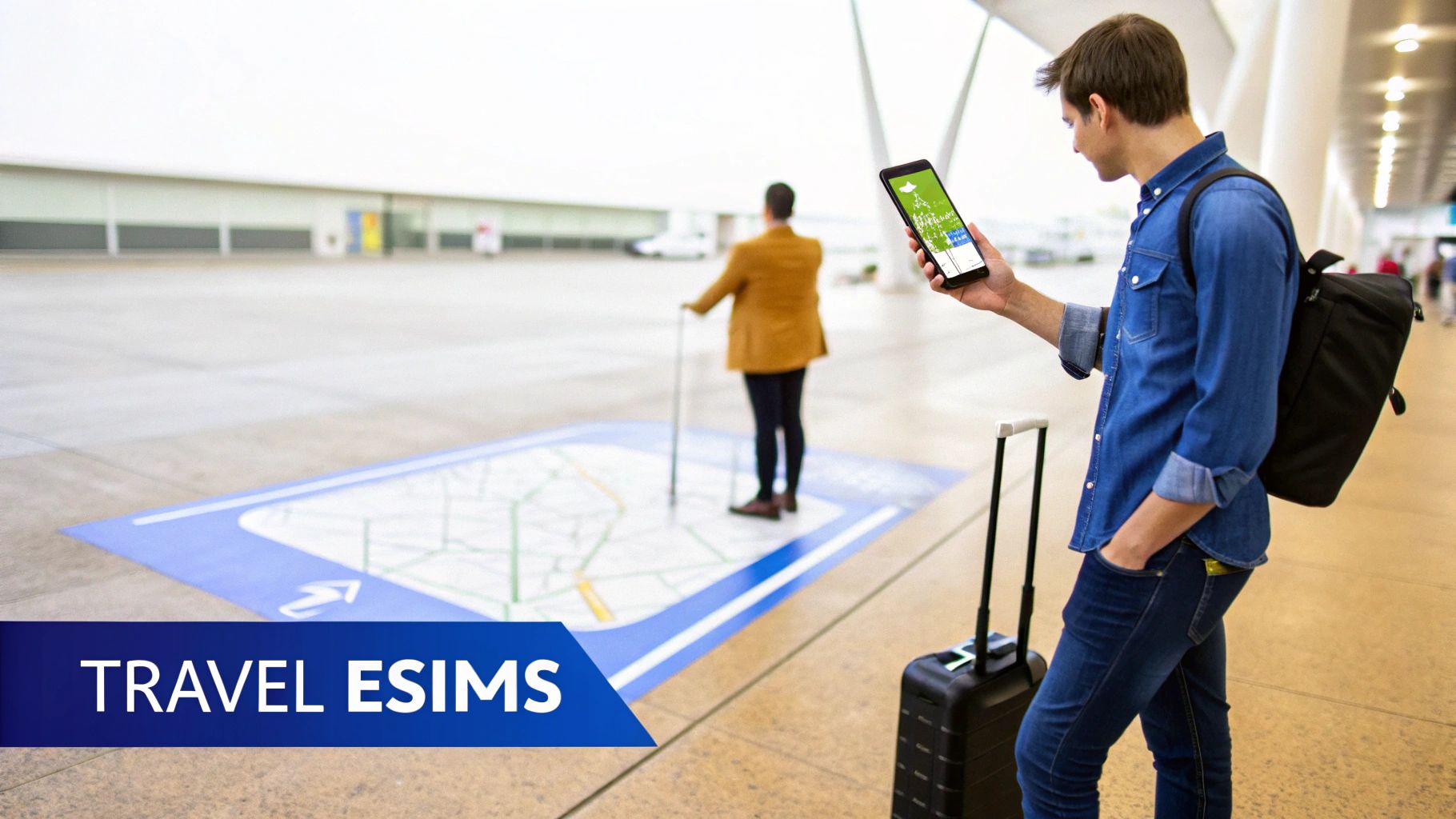
Think of an eSIM, or embedded SIM, as a digital version of the plastic SIM card you’re used to. It’s built right into your phone’s hardware, meaning you never have to physically swap out those tiny chips again. When you land in a new country, you just download and activate a local data plan. For international travellers, this is a total game-changer, transforming what was once a real chore into a simple two-minute task.
Picture this: you’ve just landed, and before the plane has even taxied to the gate, you’re already connected to the local network. No more hunting down a kiosk selling SIM cards, fumbling with language barriers, or paying inflated airport prices. With an eSIM, you buy a plan online, scan a QR code, and you’re good to go.
This digital-first approach has some serious advantages over the old ways of getting online abroad. It puts you in control and makes staying connected incredibly simple. Here’s why it’s become the go-to for savvy UK travellers:
The real magic of an eSIM is how it blends convenience with cost-effectiveness. It removes the classic travel headaches—like the desperate search for Wi-Fi or a local SIM shop—so you can focus on enjoying your trip, not on finding a connection.
The travel eSIM market is exploding, and it’s completely changing how UK travellers get online. Global revenue is predicted to reach $1.8 billion in 2025 and a staggering $8.7 billion by 2030—that’s a 380% jump. This is all thanks to the sheer number of eSIM-ready phones, set to double from 2.8 billion in 2025 to over 5.6 billion by 2030. For a bit more on this trend, check out this telecoms industry analysis.
Getting to grips with the basics is the first step to making a smart choice. For a closer look, have a read of our guide on what an eSIM is and how it works. From here, we’ll walk you through how to pick the perfect eSIM for your travel style.
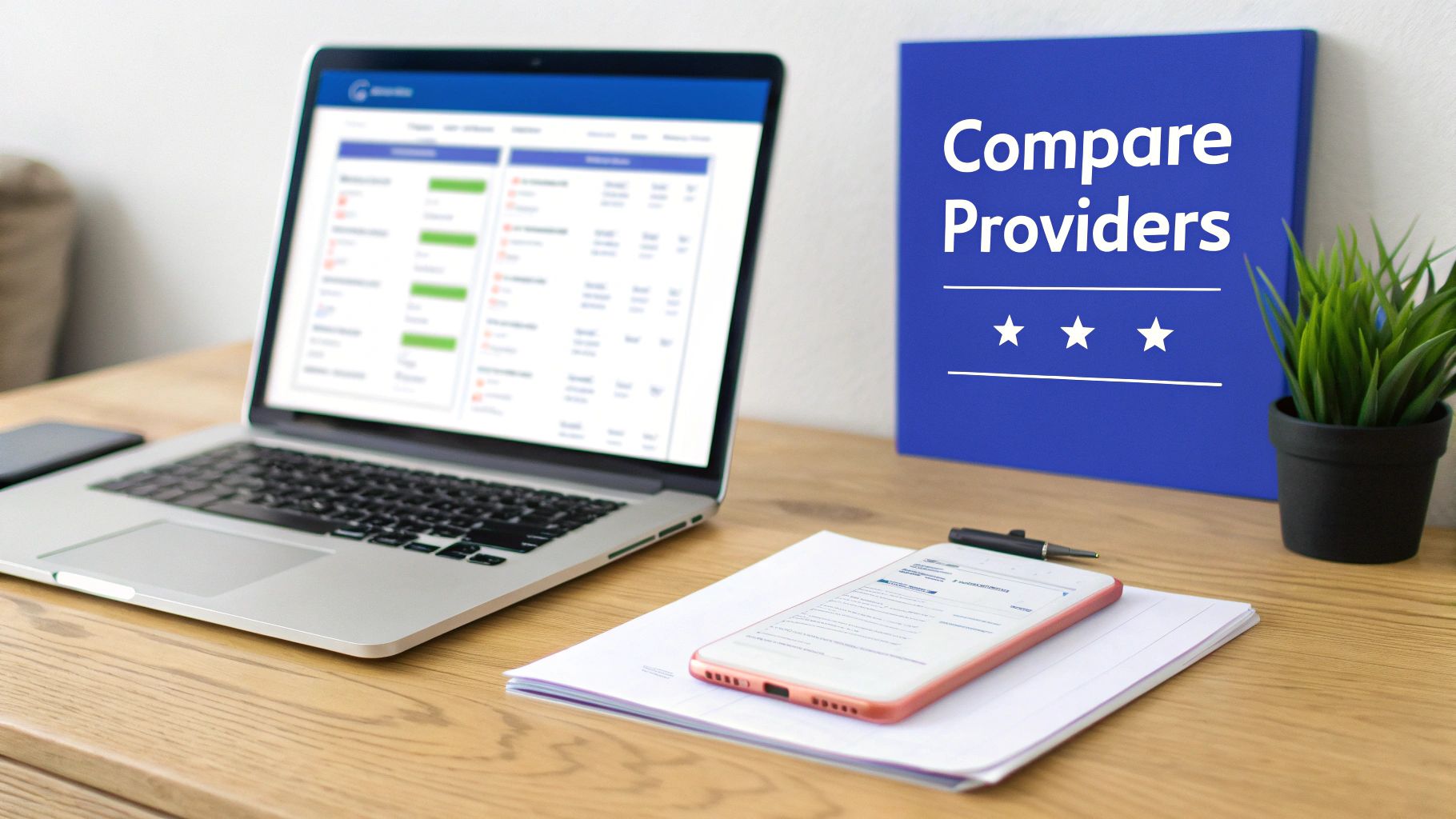
With so many eSIM providers popping up, picking the right one can feel like a bit of a minefield. It’s easy to get drawn in by flashy ads, but the secret is to focus on a few key things that genuinely affect your trip. After all, a super-cheap data plan is completely useless if it doesn’t work when you need it most.
This breakdown will give you a solid framework for comparing providers properly. By the end, you’ll be able to choose an eSIM based on your actual needs, not just a headline price, and avoid those all-too-common travel connection headaches.
This is the big one. Will your eSIM actually work well where you’re going? eSIM providers don’t own the networks; they’re essentially renting space from local carriers like Vodafone, Orange, or EE. The quality of those partnerships directly impacts your signal strength.
Before you buy anything, find out which local networks the provider uses. An eSIM that connects to a country’s top-tier carriers is a far safer bet than one piggybacking on a budget network known for spotty service outside the major cities.
An eSIM is only ever as good as the local network it connects to. Always prioritise providers that partner with major, reputable carriers in your destination countries. This is your best guarantee for a stable, reliable signal, especially if you venture beyond the city centre.
The phrase “unlimited data” often comes with a hefty catch. Many providers have a fair usage policy that kicks in after you’ve used a certain amount of data, say 2GB or 5GB in a day. Once you hit that limit, your speed gets drastically reduced—or “throttled”—making it painfully slow.
This can be a deal-breaker if you’re relying on your connection for work calls or tethering your laptop. Look for providers that are upfront about their throttling limits. Some might offer a smaller high-speed allowance at a lower price, which is fine for light browsing. Others might give you a much larger daily allowance, like 10GB of high-speed data, before the slowdown begins.
Finding the best value isn’t just about the initial price tag; it’s about the total cost. A smart way to compare is by looking at the cost-per-gigabyte. A £20 plan with 10GB of data (£2/GB) is much better value than a £15 plan that only gives you 5GB (£3/GB).
Also, keep an eye out for sneaky extras like activation fees or taxes that only appear at the final checkout. A trustworthy provider shows you the final price upfront, with no nasty surprises. To get a better handle on this, you can learn more about the advantages of an eSIM for international travel and how it simplifies budgeting for your trip.
To help you stay organised, I’ve put the most important factors into a quick checklist.
This table is a handy reference for comparing different eSIM providers. It breaks down the key factors to consider, what you should be looking for, and why each one is so important when you’re on the road.
| Evaluation Criterion | What to Look For | Why It Matters for Travellers |
|---|---|---|
| Network Partners | Partnerships with top-tier local carriers in your destination. | Ensures strong signal, fast speeds, and reliable coverage. |
| Data Throttling | Clear “fair usage policy” stating daily high-speed data limits. | Avoids unexpected slowdowns when you need a fast connection. |
| Pricing Model | Cost per gigabyte (£/GB) and clear final price with no hidden fees. | Helps you find the best true value, not just the lowest price. |
| Activation Process | Simple QR code scan and clear, easy-to-follow instructions. | A complicated setup can be a major source of stress upon arrival. |
| Hotspot Tethering | Explicit confirmation that personal hotspot or tethering is allowed. | Crucial for digital nomads or anyone needing to connect a laptop. |
Thinking through each of these points will steer you toward a reliable eSIM that fits your travel style perfectly.
The last thing you want after a long-haul flight is to be wrestling with a complicated setup process. The best providers have made it incredibly simple: you buy a plan online, get a QR code in your email almost instantly, and scan it with your phone to install the eSIM. Job done.
But sometimes, things do go wrong. Before committing, check what kind of customer support is on offer. Is there a 24/7 support for quick help, or just an email address with a 48-hour response time? Quick, responsive support can be an absolute lifesaver if you hit a snag. A provider with a clear refund policy for activation failures also offers some much-needed peace of mind.
Let’s be honest: the “best” eSIM doesn’t really exist. The best eSIM is the one that’s right for your trip, and that can change every time you pack your bags. A casual tourist exploring Rome for a weekend has completely different needs to a digital nomad setting up a temporary office in a Bali café for a month.
So, how do you cut through the noise? It all comes down to understanding your own travel persona. Once you know what kind of traveller you are, you can quickly zero in on the features that actually matter and find a plan that delivers the right mix of data, speed, and value.
If you’re off on a one or two-week holiday, your main priorities are simplicity and getting online without any fuss. You’ll need data for Google Maps, posting envy-inducing photos, looking up restaurant reviews, and messaging family back home. You’re probably not planning on tethering a laptop for hours on end.
For this kind of trip, here’s what to look for:
Your best bet is a provider with a balanced, user-friendly experience and clear data limits. Don’t fall for the “unlimited” plans—their fair use policies often mean you’re just paying a premium for data you’ll never touch.
When you’re travelling for work, your connection isn’t just a nice-to-have; it’s mission-critical. Your biggest concern is rock-solid reliability for video calls, pulling files from the cloud, and keeping in touch with your team. A dropped signal or slow speeds simply isn’t an option.
For business travel, prioritise providers that partner with top-tier local networks. A stable, fast connection is non-negotiable, and the quality of the underlying carrier is the single most important factor in ensuring your productivity isn’t interrupted.
Key features for the travelling professional include:
Digital nomads and long-term backpackers are in a league of their own. They chew through huge amounts of data over extended periods for both work and play, and they value flexibility above all else. Their internet usage looks a lot more like it would at home.
The best eSIM for this lifestyle has to deliver:
For the backpacker watching every penny, the name of the game is finding the cheapest option that gets the job done. You need just enough data for the essentials: booking hostels, checking bus timetables, and finding your way around with a map. Wi-Fi will be your best friend, but a little data is crucial.
Here, the focus shifts to pure value:
By matching your travel style to these specific features, you can confidently pick the right eSIM for your journey, making sure you stay connected without overspending or sacrificing reliability.
Getting started with a travel eSIM is far less intimidating than it sounds. The whole point is to ditch the faff of finding a shop, fiddling with tiny plastic cards, and dealing with language barriers. Instead, you can get online in a new country almost as soon as you land, all from your phone.
Let’s walk through how it actually works. After picking an eSIM provider and buying a plan online, a QR code usually lands in your inbox within minutes. Think of this as your digital key to getting connected.
This infographic breaks down how your travel style points to the right kind of eSIM plan.
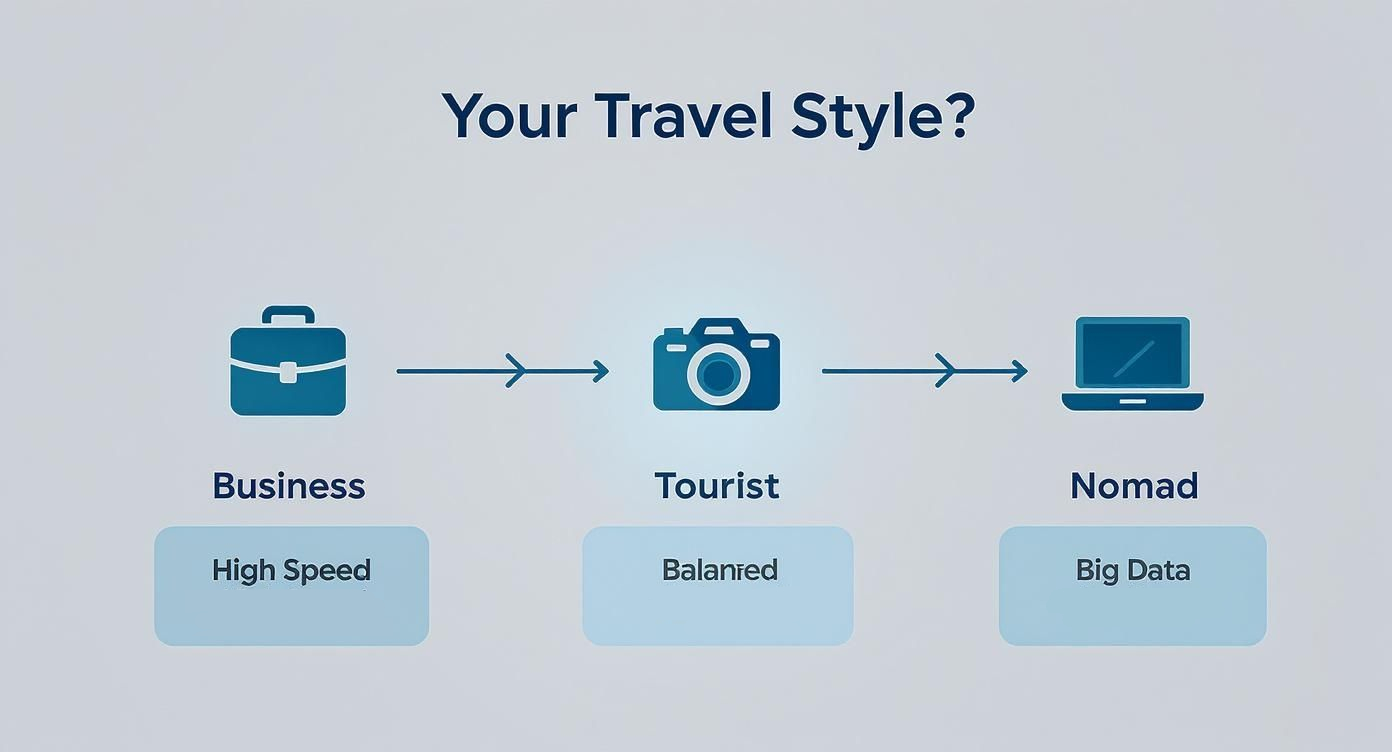
As you can see, the secret is matching the plan’s features to your trip. A business traveller needs reliable, high-speed data, while a digital nomad might prioritise a huge data bundle. Aligning your plan with your real-world needs is the smartest way to choose.
The exact wording might change a little between an iPhone and an Android device, but the steps to install an eSIM are fundamentally the same.
When your plane touches down, just go into your phone’s mobile data settings and switch it from your home SIM to your new travel eSIM. It’s the one step people often forget in the rush of arrival, so make it a priority.
Once you’re up and running, keeping an eye on your data is simple. Most providers have an app or a website login where you can see your data usage in real-time. It’s a great way to make sure you don’t run out unexpectedly.
If you do find your data is getting low, topping up is just as easy as the first purchase. You can usually add more data directly through the provider’s app with a couple of taps, keeping you connected without any interruption.
This level of convenience is precisely why eSIMs are taking off. Their adoption is surging in the UK and around the world, with experts predicting 1 billion smartphone eSIM connections by 2025. This shift is being helped along by a 33% year-on-year increase in the number of phones that support eSIMs.
Let’s be honest, wading through the sea of eSIM providers can be a real headache. With so many options, it’s easy to get lost. But finding the right fit isn’t about just grabbing the cheapest deal; it’s about matching a provider’s strengths to your specific travel plans. This is exactly where TapSim comes in, offering a clear, no-nonsense way to stay connected.
For those of us travelling from the UK, the boom in the domestic eSIM market is fantastic news. Projections show the UK eSIM market growing from USD 867.9 million in 2024 to nearly USD 1.5 billion by 2033. What does that mean for you? Better service, more innovation, and sharper pricing as companies compete for your business. You can dive deeper into this market growth on Data Bridge Market Research.
We built TapSim to tackle the frustrations we’ve all felt with travel connectivity. Our goal is simple: deliver a dependable connection without the confusing small print and hidden catches that plague so many other services.
Our real strength comes from the solid partnerships we’ve built with top-tier network operators in over 150 destinations. This isn’t just a number; it means you get reliable 4G and 5G speeds where it’s available. No more dropped signals when you’re trying to pull up a map or join a crucial video call.
A travel eSIM should make your life easier, period. We designed TapSim around a fuss-free experience—from the moment you get your QR code to managing your plan in our simple app. The less time you spend fiddling with settings, the more time you have to actually enjoy where you are.
We’re firm believers in clear, upfront pricing. With TapSim, what you see is what you get. Our plans come with straightforward data allowances and no hidden fees waiting to bite you later.
You won’t find any vague “unlimited” plans here that secretly slow you to a crawl after you’ve used a few gigabytes. We tell you exactly how much high-speed data you have, so you can pick a plan that actually works for how you use your phone.
Plus, all our plans are hotspot-enabled. That means you can easily share your connection with a laptop or with your family, a must-have for anyone working on the road or travelling in a group. And if you run low? Our top-up system is simple and puts you in control. It’s this mix of reliability, honesty, and practical features that makes TapSim a solid choice for anyone looking for the best eSIM for travel.
It’s completely normal to have a few questions before you make the switch to an eSIM, especially for the first time. Let’s clear up some of the most common queries we get from travellers just like you.
Yes, you absolutely can, and this is one of the standout perks of using an eSIM abroad. Your physical SIM card doesn’t go anywhere; it stays right in your phone.
This means you can keep receiving calls and texts on your usual UK number without a problem. You just tell your phone to use the travel eSIM for all mobile data. It’s the best of both worlds – you won’t miss any important bank verification codes, but you also won’t get hit with eye-watering data roaming fees from your home provider.
Most phones made in the last few years have eSIM capability built-in, but it’s always smart to double-check before buying a plan. Thankfully, it only takes a second.
Still not certain? A quick online search for “[Your Phone Model] + eSIM compatibility” will give you a firm answer in moments.
The last thing you want is to land at your destination and find out your phone isn’t compatible. Take a moment to run this simple check at home before you buy an eSIM plan to guarantee a stress-free start to your holiday.
This really comes down to the provider’s specific terms, so it’s something worth looking into before you commit. The better providers tend to have flexible, customer-friendly policies for when things don’t go to plan.
For instance, many (including TapSim) will offer a full refund if you need to cancel before the eSIM has been activated. Since you should only activate it once you arrive, this gives you a great safety net if your plans suddenly change.
Ready to travel smarter and stay connected without the hassle? TapSim offers reliable, transparent eSIM plans for over 150 destinations, so you can land and get online in minutes. Find the perfect plan for your next adventure today.

